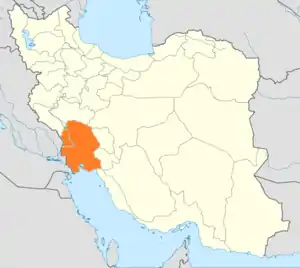1979 Khuzestan insurgency
The 1979 Khuzestan uprising was one of the nationwide uprisings in Iran, which erupted in the aftermath of the Iranian Revolution. The unrest was fed by Arab demands for autonomy.[2] The uprising was effectively quelled by Iranian security forces, resulting in more than a hundred people on both sides killed.[2]
| 1979 Khuzestan uprising | |||||||
|---|---|---|---|---|---|---|---|
| Part of Consolidation of the Iranian Revolution and Arab separatism in Khuzestan | |||||||
 Khūzestān Province of Iran, native name, استان خوزستان | |||||||
| |||||||
| Belligerents | |||||||
|
Supported by: |
| ||||||
| Commanders and leaders | |||||||
|
|
| ||||||
| Units involved | |||||||
| Strength | |||||||
| A few hundred (AFLA)[1] | |||||||
| Casualties and losses | |||||||
| 100 Iranian Arabs killed[2] | More than a dozen pasdarans killed[2] | ||||||
| Total: 25[3]–112 killed | |||||||
Background
The Arabs of Iran are largely concentrated in the province of Khuzistan and number between half a million to 2 million.[4] In Khuzestan, Arabs have formed the dominant ethnic group in Shadegan, Hoveyzeh and Susangerd, a majority in Mahshahr, Khorramshahr, Abadan and Ahvaz.[5]
Inside Iran, the communal relationship between the majority Persians and ethnic minorities seems to have changed when the Islamic Republic was formed in 1979. In part, this was a result of the Persian community’s identification with the Islamic Republic, although some Arabs do identify with the Islamic republic as well.[6]
History
Following the events of the Iranian revolution, Marxist guerrillas and federalist parties revolted in some regions comprising Khuzestan, Kurdistan and Gonbad-e Qabus, which resulted in fighting between various rebel groups and revolutionary forces. The largest rebellion by the Kurds unfolded in the West (Iranian Kurdistan), though the Pasdaran were also confronted by Arabs, Turkomans and Baluchs.[2] These revolts began in April 1979 and lasted between several months to over a year, depending on the region. In the early days of the communal conflict, the regime relied on volunteers from the Persian and Azeri communities to confront Kurdish, Baluchi, and Turkoman rebellions.[6] In late April and into May 1979, Arabs of Khuzestan began protests against discrimination, which prompted the regime to send Pasdaran units to assist already deployed navy and air force personnel (in Khorramshahr) in quelling the violence.[2] According to EIR News Service issue from December 1979, while "half of Iran" was in rebellion, the situation in Khuzestan province had already calmed down, even though Arab and Bakhtiari tribes were reportedly at odds with Khomeini's regime.
Casualties
More than a dozen Revolutionary Guards (Pasdaran) and 100 Arabs died in the battles.[2]
Aftermath
One of the consequences of the Arab uprising in Khuzestan was the Iranian Embassy siege, which took place from 30 April to 5 May 1980, after a group of six armed men stormed the Iranian embassy in South Kensington, London. The gunmen took 26 people hostage—mostly embassy staff, but several visitors and a police officer, who had been guarding the embassy, were also held. The hostage-takers, members of a group campaigning for the autonomy of Iran's Khuzestan Province, demanded the release of Arab prisoners from jails in Khūzestān and their own safe passage out of the United Kingdom. The British government quickly resolved that safe passage would not be granted, and a siege ensued. During the 17-minute raid, the SAS rescued all but one of the remaining hostages, and killed five of the six terrorists. The soldiers subsequently faced accusations that they unnecessarily killed two of the terrorists, but an inquest into the deaths eventually cleared the SAS of any wrongdoing. The remaining terrorist was prosecuted and served 27 years in British prisons.
Later in 1980, The Khuzestan province has become a central scene of the Iran–Iraq War, which prompted the dimming of internal conflict, despite the Iraqi hopes of inciting a wide-scale rebellion by Arabs of Khuzestan, which eventually turned vague.[7] Annexation of the Khuzestan province in fact had been among the four main goals of the Iraqi invasion into Iran in 1980.
The tensions between the Iranian government and the Arab population of Khuzestan has sporadically exploded into violence over the next decades. In 2005, violent riots broke out in Khuzestan province, concentrating in the Ahvaz area. As a result, several people died and wide scale arrests were performed by Iranian authorities. Following the events, a series of bombings were carried out in Khuzestan and in cities across Iran, claiming 28 casualties. The responsibility for the bombings were claimed by Ahvaz Arab separatists.
References
- Razoux, Pierre (2015). The Iran-Iraq War. Hrvard University Press. Appendix E: Armed Opposition. ISBN 9780674915718.
- Ward, p.231-4
- "Archived copy". Archived from the original on 2014-07-19. Retrieved 2012-10-21.CS1 maint: archived copy as title (link)
- J. Lorentz, 1995, p.172.
- Iran Overview from British Home Office Archived July 18, 2009, at the Wayback Machine
- Karsh, Efraim The Iran-Iraq War 1980–1988, London: Osprey, (2002): page 27.